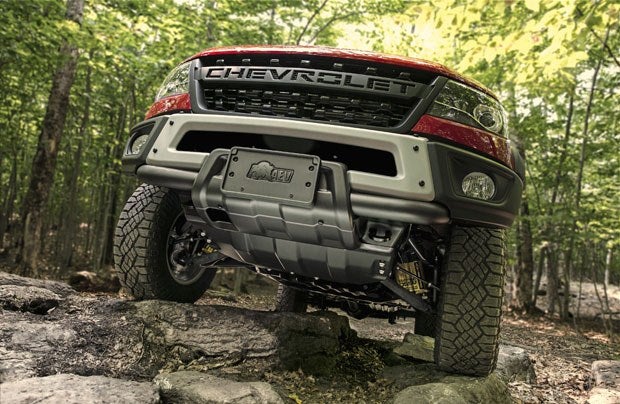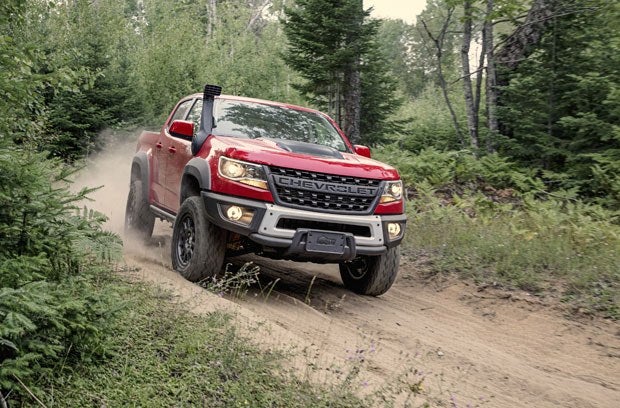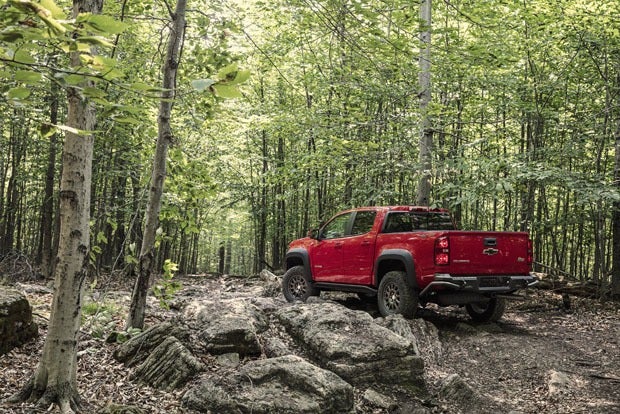
With the Chevrolet ZR2 Bison and its apocalyptic style hitting the internet last week, we thought it’d be a good chance to put it up against the Toyota Tacoma TRD Pro.
Teaming up with the aftermarket house American Expedition Vehicles (AEV), Chevrolet has taken the best parts of the ZR2 pickup and cranked them up to eleven. Snorkel, stamped-steel bumpers, and those mighty DSSV shocks make for one mean Bison machine.

In other corner, wearing a flat-brimmed Toyota hat, we find the TRD Pro. This pickup builds on the older-than-Methuselah Tacoma, which is not necessarily a bad thing. The company amps up the off-road volume by adding a computer-controlled crawl control system that manages things like wheel slip to make its driver look like a mud-streaked hero.
Let’s start with a few numbers. Chevy isn’t saying if the Bison’s extra equipment adds anything in the angle-of-attack department, so let’s assume for the moment it does not. A stock ZR2 has an approach angle of 30 degrees, failing to keep up with the TRD Pro’s 36 degrees. Departure angles are similar between the two but the Big T outstrips the Bowtie in ground clearance. The Taco does claim better numbers in this department.

Where the Bison picks up off-road cred is in the shock and yaw department. Chevy made the right choice to install Multimatic DSSV units which allow the bowtie brand better wheel travel and more articulation. In addition, these trick units are able to offer jump landings that won’t knock the fillings out of your teeth while still providing a decent on-road ride while driving back home from the trailhead. Advantage, Chevy.
Both trucks offer treats and goodies to help pound through the off-road scenery. The Tacoma’s Multi Terrain and Crawl Control systems are available when the truck is in 4Lo. They’re operated via roof-mounted controls which allow drivers to act out all their Top Gun fantasies, an intangible bonus. Multi Terrain uses brake pressure and throttle response to regulate wheelspin, allowing for better traction depending on your circumstances. Crawl control permits a crawl speed of between 1mph and 5mph for slowly creeping on hills or over obstacles without using the pedals.
Chevy’s trick is more mechanical than the ‘Yota. Front and rear lockers are driver selectable via satisfyingly tactile dash-mounted switches, while the addition of an Off-Road mode allows for a bit more wheelspin for those who want to kick up dirt in a lurid powerslide. Both are capable; whether one prefers analog or digital is up to you.

In the powertrain department, both models give shoppers choice … kind of. The Toyota has a single engine from which to select, a capable 3.5L V6 making 278 horsepower, but it does its part to Save the Manuals by offering a six-speed stick. In this day and age, that’s no small detail.
The Chevy is automatic-only but has the choice of a 308hp V6 or a diesel I-4 with 368lb-ft of torque, with both those mills slated for the Bison. Your author has driven all four and, perhaps unsurprisingly, enjoyed the Tacoma’s manual transmission to its automatic. In the Chevy, the high-revving gasoline engine was preferred.
General Motors has remained mum on price for the Bison but expect a premium over the ZR2 whose Crew Cab iteration rings in at $42,500. A manually-shifted TRD Pro with four forward-swinging doors stickers for $42,660.

We smell a head-to-head test coming up. Stay tuned.